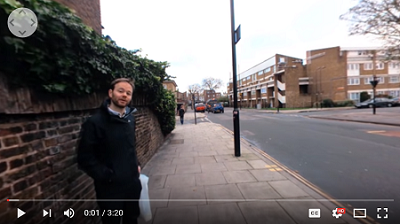Like walking in the shoes of a person with dementia
Innovative immersive videos enabling People Without Dementia (PWoD) to experience how a Person With Dementia (PWD) perceives and navigates life—from trying to interpret what one sees and forgetting simple instructions to becoming disoriented with heart-pounding panic. After hundreds of hours interviewing people with different types of dementia, the Alzheimer’s Research UK team distills their experiences into four short videos.
Four Videos
Launch Film
This initial video explains how and why this virtual reality series was made and introduces us to two couples. Vicky & Martin, a young couple, decide to kick Alzheimer’s to the curb and enjoy moments in their lives. Before Trina was diagnosed with Posterior Cortical Atrophy (PCA), she was the organizer who took care of the details. Now she needs her husband, Graeme’s help. Hyper alert, she can see, but cannot perceive what she sees. “There’s no connection between my brain and my eyes. The connection has been broken.” https://www.youtube.com/watch?v=nW1Y3Fnv7Mw 7 minutes
Walking Home
 Joe and his mom are walking home when he receives a call and is temporarily distracted. His mom, feeling she can find her way, goes ahead. Soon the familiar becomes unrecognizable and she panics. Her heart is pounding. When her son catches up, they walk. Suddenly, she freezes before a gaping hole in the sidewalk. Her son says, “It’s just a puddle, that’s all,” but she’s not too sure. https://www.youtube.com/watch?v=R-Rcbj_qR4g 3 minutes
Joe and his mom are walking home when he receives a call and is temporarily distracted. His mom, feeling she can find her way, goes ahead. Soon the familiar becomes unrecognizable and she panics. Her heart is pounding. When her son catches up, they walk. Suddenly, she freezes before a gaping hole in the sidewalk. Her son says, “It’s just a puddle, that’s all,” but she’s not too sure. https://www.youtube.com/watch?v=R-Rcbj_qR4g 3 minutes
At Home
Mom takes a call from her daughter who’s coming over with two friends. She asks, “Can you put the kettle on?” When Mom asks her what she’ll have, her daughter requests “the usual.” As Mom tries to remember which cup gets the “milk and two sugars” and so on, she’s thrown off-balance when she doesn’t see the tea bags that were there a moment ago. https://www.youtube.com/watch?v=9GBXEjw3iHw 3 minutes
At the Supermarket
A creatively engaging animated short, exclusive to those who download A Walk through Dementia app.
Key Takeaways
- Eye-opening, yet heartbreaking
- Trying to function with dementia is stressful and exhausting.
- One tries to avoid embarrassment despite heart pounding with fear while forgetting and becoming disoriented.
- To relate, consider your state of panic when you lose your smartphone, lock your keys in the car, or lose your wallet/purse. Your heart races and you stop thinking clearly.
- Accessible technology will encourage more people to view these videos and talk about dementia in order to keep it in the forefront of people’s minds; thus, influencing policy and funding decisions.
Eventually, PWDs will withdraw from social activities, because it takes too much energy and is exhausting. Family members can help postpone this withdrawal if they notice, have the energy, and are willing to help loved ones feel safe. For example, once the son realizes his mother is struggling to hold it all together, he can take her arm as they walk together. Approaching the puddle, he’ll know to say, “Let’s go around this, Mum.” In this way, she feels her perceptions are being acknowledged without even having to express them. Over time, she feels safe when she’s with her son.
Viewing Options
The intended viewing method is to download the app as an Android-exclusive Google Cardboard experience. For more information, visit http://www.awalkthroughdementia.org
If you click to install the app, the developers warn you to use Wi-Fi, so you don’t use of your mobile data allotment. The app is huge at 614MB. Once you download and install it, it gives you a choice to view with Cardboard (dual lens) or phone only (single lens).
Maybe I’m old fashioned or because I didn’t have the Cardboard, I preferred watching it on my monitor and using my mouse to explore the viewing area.
A Walk through Dementia, a collaboration between Alzheimer’s Research UK and Visyon, gets PWoDs close to walking in the shoes of a PWD. I hope this is the beginning of what other agencies around the world will build upon to raise awareness and understanding of living with the different forms of dementia such as fronto-temporal lobe, Parkinson’s, Lewy body, and more.









Another great resource that I wish I was exposed to. There was no Dementia 101 and how to deal with it. My advice and guidance was through Brenda, Gary and Bernadette. I always felt why was this happening and whys. I still wonder why my Marie but more important I wish I had the guidance to me other then what I had. Maybe if I could have seen this series and walked the walk in dementia I would dhave understood more. But, Brenda, Gary and Bernadette I can not give enough thanks to.